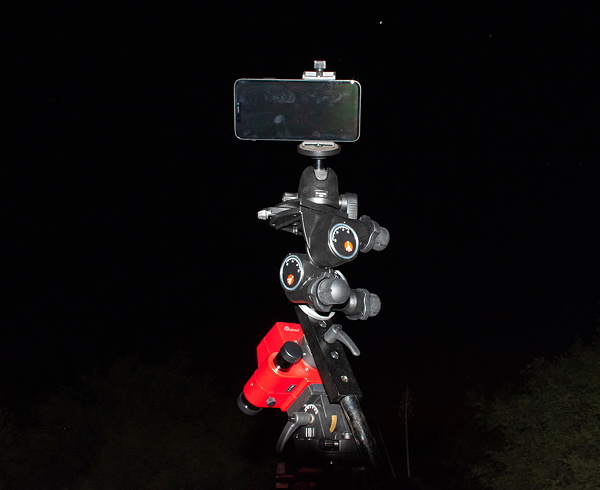iPhone 11 Pro Max Sky Astrophotography
Posted: 16 October 2019
Unforecasted clouds appeared mid-day on Monday, 14 October 2019, and continued into the night. The sky was mostly clear on Tuesday, 15 October.
|
Open: Tuesday, 15 October 2019, 1809 MST Temperature: 86°F |
Session: 1396 Conditions: Mostly clear |
Equipment Used:
12" f/8 LX600 w/StarLock
2" 24mm UWA eyepiece
SkyTracker Pro
Camera:
iPhone 11 Pro Max
I set up the iPhone 11 Pro Max on the iOptron SkyTracker Pro mount using the Levenhuk adapter. I would use both portrait and landscape orientations of the iPhone.


1831 MST: LX600 ON, StarLock OFF, High Precision OFF.
1834 MST: viewed the planet Jupiter and four moons, 102X. Then viewed Saturn and two of its moons, 102X.
This night Moonrise and the end of Astronomical Twilight would both occur about 1915 MST. So I would need to begin doing sky photography as soon as the sky darkness allowed.
1844 MST: polar aligned the SkyTracker Pro.
1849 MST: took this handheld iPhone 11 Pro Max photo of the sky using Night Mode of the Camera app (3 seconds, 1X lens). It shows the constellation of Cassiopeia at the left, the Great Square of Pegasus at the right, a satellite, and even the Andromeda Galaxy (M31).

Mouseover or tap on image for labels
This is a handheld iPhone photo (Night Mode, 3 seconds, 1X lens) of the Milky Way. It shows some digital noise.

I then mounted the iPhone on the SkyTracker Pro. I used the Apple Watch Camera app as a remote shutter release for some of the images below. I also used the Phone Skope Bluetooth Remote for others.

Here are some Milky Way photos taking using Night Mode (1X lens). Some post-processing was done.
5 seconds

28 seconds

5 seconds

28 seconds

Obviously the longer the exposure the less digital noise that will appear, resulting in a better photo. Next week I'll be at a site where there will be no sky glow to the south. I plan to do more iPhone Milky Way astrophotography from there.
1920 MST: the eastern sky was brightening from the rising waning gibbous Moon. Ended iPhone sky astrophotography.
1931 MST: last look at Saturn, 102X.
1933 MST: LX600 OFF.
|
Close: Tuesday, 15 October 2019, 1945 MST Temperature: 71°F |
Session Length: 1h 36m Conditions: Clear |
The following morning I did some more iPhone 11 Pro Max tests using an inexpensive clip-on 8X telephoto lens. These photos show Kitt Peak National Observatory (65 miles away).
Camera app (1X lens)

Camera app (2X lens)

Camera app (1X lens + 8X telephoto)

NightCap Camera app (2X lens + 8X telephoto)

The Camera app had no difficulty doing its automatic focus when using the 8X telephoto over the 1X lens, but it could not autofocus with the 8X telephoto over the 2X lens. Using NightCap Camera with its manual focus control allowed focus to be reached with the 2X lens + 8X telephoto.
Comments are welcome using Email. Twitter users can use the button below to tweet this report to their followers. Thanks.
Cassiopeia Observatory Home Page
Copyright ©2019 Michael L. Weasner / mweasner@me.com
URL = http://www.weasner.com/co/Reports/2019/10/16/index.html
